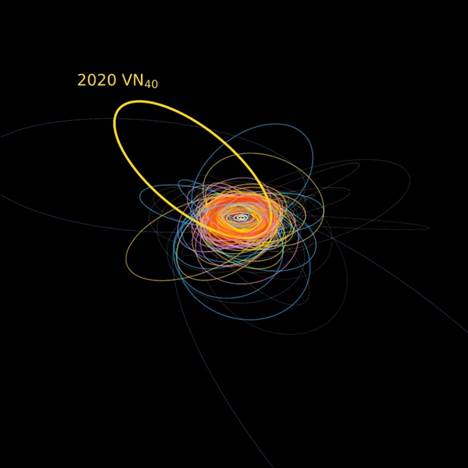An international team of Astronomers has discovered a rare, distant object far beyond Neptune that's moving in rhythm with the giant planet. The object, named 2020 VN40, is part of a group called trans-Neptunian Objects (TNOs) - minor planets that are typically bodies of rock and ice that orbit the Sun beyond Neptune. It's the first confirmed object that completes one full orbit around the Sun for every ten orbits Neptune makes.

This image shows the orbits of all of the objects discovered in the Outer Solar System Origins Survey (fainter lines) and LiDO (thicker lines). The orbit of 2020 VN40 is the thickest one, tilted up and to the left from the orbits of most of the objects. The orbits of the giant planets (Jupiter, Saturn, Uranus, and Neptune) are the white circles inside most of the orbits.
This discovery provides scientists with new insights into how objects in the outer Solar System behave and how they got there. It also supports the idea that Neptune's gravity can temporarily "catch" objects as they pass by.
"This is a big step in understanding the outer Solar System," said Dr. Rosemary Pike, lead researcher from the Center for Astrophysics | Harvard & Smithsonian. "It shows that even very distant regions influenced by Neptune can contain objects, and it gives us new clues about how the solar system evolved."
The discovery comes from the LiDO (Large Inclination Distant Objects) survey, which searches for unusual objects in the outer Solar System. The survey uses the Canada-France-Hawaii Telescope (CFHT) for the main survey operations, as well as additional observations from Gemini Observatory and the Magellan Baade Telescope, which help to track especially exciting discoveries like this one.
LiDO focuses on finding objects with orbits that are tilted far above or below the plane of the Earth's orbit around the Sun - areas that have been hard to study in the past.
"It has been fascinating to discover how many small bodies in the Solar System exist on these very large, very tilted orbits," said Dr. Samantha Lawler, associate professor of astronomy at the University of Regina and a core member of the LiDO team.
2020 VN40 orbits the Sun at an average distance about 140 times farther than Earth, following one of those extreme, tilted paths. What makes this object even more interesting is how it lines up with Neptune's orbit. Usually, when objects orbit in a simple pattern with Neptune like one orbit for every ten of Neptune's, they stay far away from Neptune when they're closest to the Sun. But 2020 VN40 appears to come close to Neptune when it's near the Sun, at least when viewed from above the Solar System.
In reality, they're still far apart because 2020 VN40's orbit is tilted so steeply that it passes far below the plane of the Solar System. But even in this "flattened" map-like view, no other known TNOs with similar orbits show this kind of alignment.
"This new motion is like finding a hidden rhythm in a song we thought we knew," said Dr. Ruth Murray-Clay from the University of California Santa Cruz and co-author of the study. "It could change how we think about the way distant objects move."
The discovery shows that highly tilted orbits can create new, unexpected patterns of movement. The LiDO survey has already found over 140 distant objects, and with powerful new telescopes like the Vera C. Rubin Observatory coming online, astronomers expect to find many more.
"Distant, weird orbits like this one are unexpected, and the fact that it exists teaches us so much about the history of our Solar System," says Lawler.
CFHT and Gemini Observatory are both funded in part by the National Research Council of Canada.
Read the full paper here: https://iopscience.iop.org/article/10.3847/PSJ/addd22










